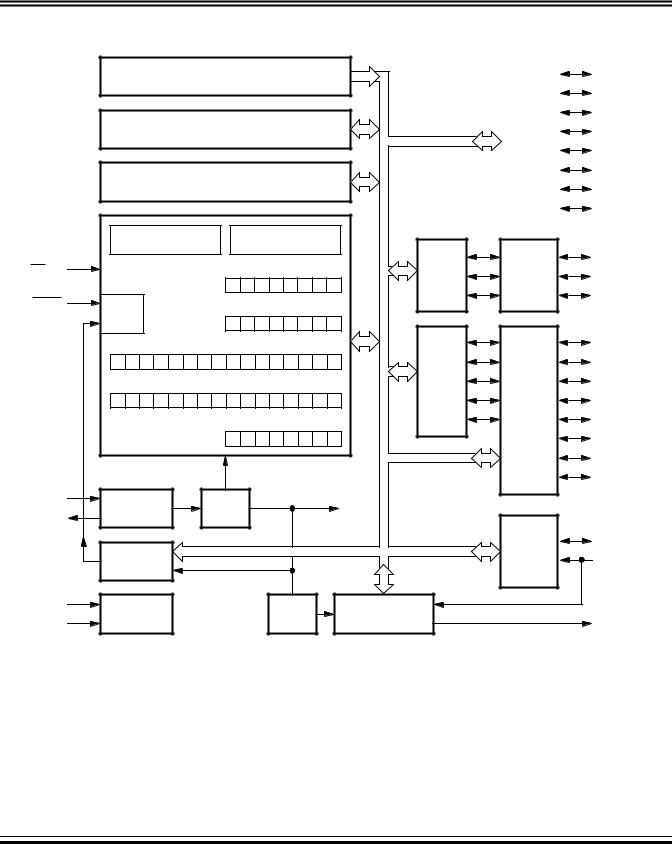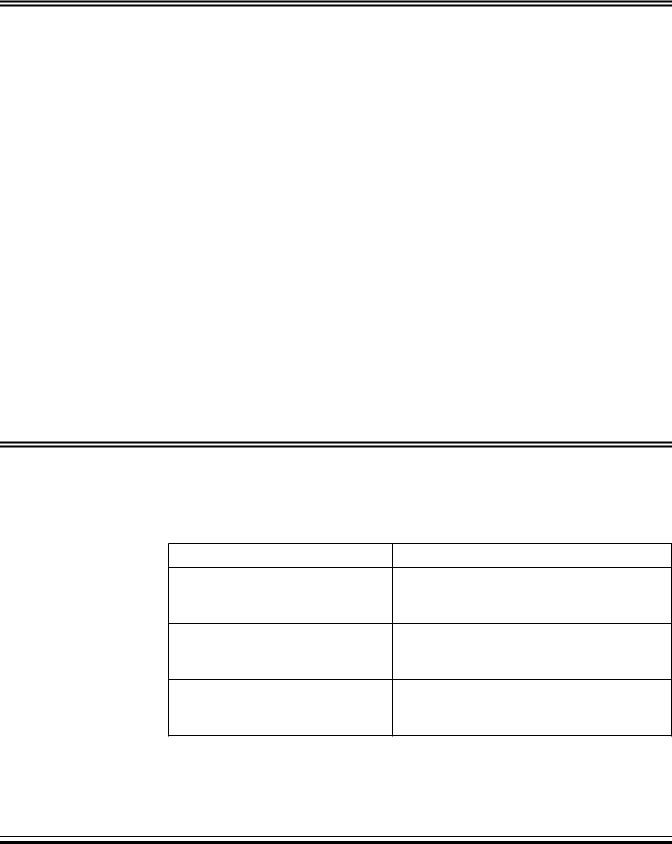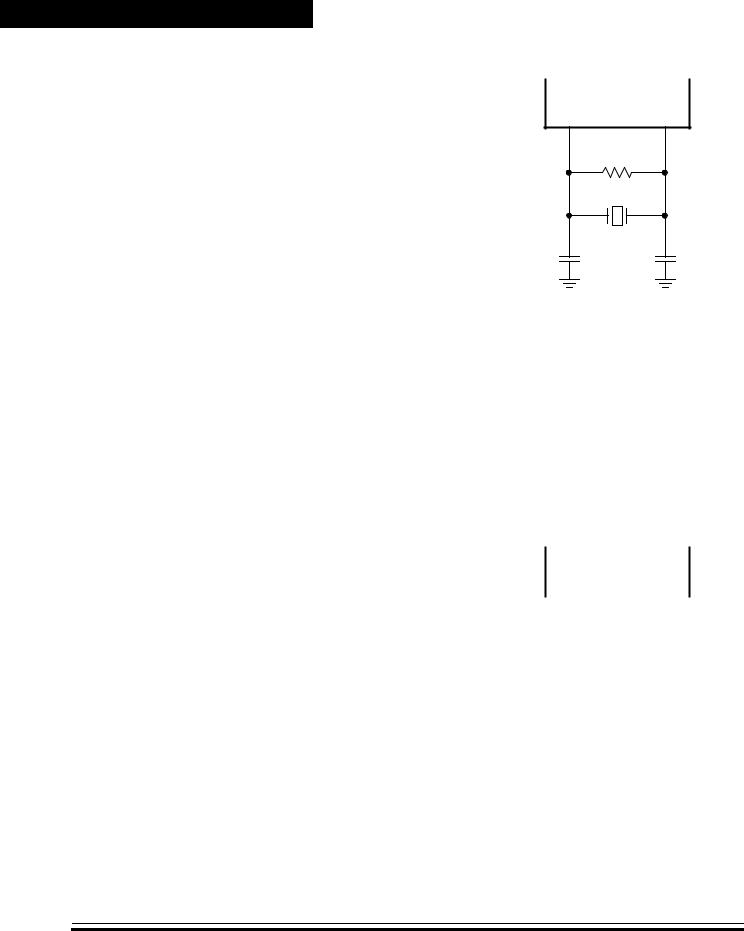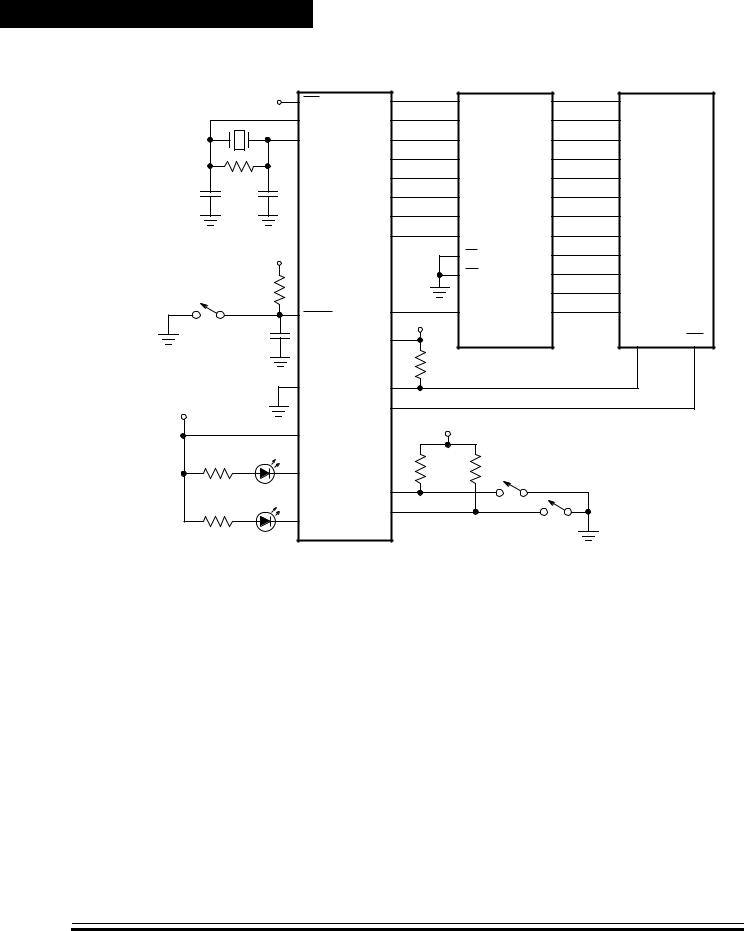Motorola MC68HC705P9S, MC68HC705P9VDW, MC68HC705P9VP, MC68HC705P9MS, MC68HC705P9CS Datasheet
...
MC68HC705P9/D
REV. 3
MC68HC705P9
HCMOS Microcontroller Unit
TECHNICAL DATA

M O T O R O L A
CSIC
MICROCONTROLLERS

List of Sections
Table of Contents . . . . . . . . . . . . . . . . . . . . . . . . . 5
Introduction . . . . . . . . . . . . . . . . . . . . . . . . . . . . . . 9
Pin Descriptions . . . . . . . . . . . . . . . . . . . . . . . . . . 13
Memory . . . . . . . . . . . . . . . . . . . . . . . . . . . . . . . . 19
Central Processor Unit (CPU) . . . . . . . . . . . . . . . 33
Resets and Interrupts. . . . . . . . . . . . . . . . . . . . . . 55
Low-Power Modes. . . . . . . . . . . . . . . . . . . . . . . . 65
Parallel I/O Ports . . . . . . . . . . . . . . . . . . . . . . . . . 71
Computer Operating Properly
Watchdog (COP) . . . . . . . . . . . . . . . . . . . . . . 85
Timer . . . . . . . . . . . . . . . . . . . . . . . . . . . . . . . . . . . 89
Serial Input/Output Port (SIOP). . . . . . . . . . . . . 107
Analog-to-Digital Converter (ADC). . . . . . . . . 121
Specifications . . . . . . . . . . . . . . . . . . . . . . . . . . 131
Index . . . . . . . . . . . . . . . . . . . . . . . . . . . . . . . . . 145
Literature Updates . . . . . . . . . . . . . . . . . . . . . . . 151
Motorola, Inc., 1996
MOTOROLA |
3 |

List of Sections
List of Modules
List of Modules
All M68HC05 microcontroller units (MCUs) are customer-specified modular designs. To meet customer requirements, Motorola is constantly designing new modules and new versions of existing modules. The following table shows the version levels of the modules in the MC68HC705P9 MCU.
Module |
Version |
|
|
Central Processor Unit (CPU) |
HC05CPU |
|
|
Timer |
TIM1IC1OC_A |
|
|
Serial Input/Output Port (SIOP) |
SIOP_A |
|
|
Computer Operating Properly Watchdog (COP) |
COP0COP |
|
|
Analog-to-Digital Converter (ADC) |
ATD4X8NVRL |
|
|
Revision History
The following table summarizes differences between this revision and the previous revision of this Technical Data manual.
Previous |
2.0 |
|
Revision |
||
|
||
|
|
|
Current |
3.0 |
|
Revision |
||
|
||
|
|
|
Date |
11/95 |
|
|
|
|
Changes |
Format and organizational changes |
|
|
|
|
Location |
Throughout |
|
|
|
4 |
MOTOROLA |

|
|
Table of Contents |
List of Sections |
List of Modules . . . . . . . . . . . . . . . . . . . |
. . . . . . . . . . . . . . . . . . . . . . . .4 |
|
Revision History. . . . . . . . . . . . . . . . . . . . |
. . . . . . . . . . . . . . . . . . . . . . .4 |
Introduction |
Contents . . . . . . . . . . . . . . . . . . . . . . . . . |
. . . . . . . . . . . . . . . . . . . . . . .9 |
|
Features . . . . . . . . . . . . . . . . . . . . . . . . . |
. . . . . . . . . . . . . . . . . . . . . .10 |
|
Structure . . . . . . . . . . . . . . . . . . . . . . . . . |
. . . . . . . . . . . . . . . . . . . . . .11 |
|
Package Types and Order Numbers . . . . |
. . . . . . . . . . . . . . . . . . . . . .12 |
|
Programmable Options . . . . . . . . . . . . . . |
. . . . . . . . . . . . . . . . . . . . . .12 |
Pin Descriptions |
Contents . . . . . . . . . . . . . . . . . . . . . . . . . |
. . . . . . . . . . . . . . . . . . . . . .13 |
|
Pin Assignments . . . . . . . . . . . . . . . . . . . |
. . . . . . . . . . . . . . . . . . . . . .14 |
|
Pin Functions. . . . . . . . . . . . . . . . . . . . . . |
. . . . . . . . . . . . . . . . . . . . . .15 |
Memory |
Contents . . . . . . . . . . . . . . . . . . . . . . . . . |
. . . . . . . . . . . . . . . . . . . . . .19 |
|
Features . . . . . . . . . . . . . . . . . . . . . . . . . |
. . . . . . . . . . . . . . . . . . . . . .19 |
|
Memory Map . . . . . . . . . . . . . . . . . . . . . . |
. . . . . . . . . . . . . . . . . . . . . .20 |
|
Input/Output Register Summary . . . . . . . |
. . . . . . . . . . . . . . . . . . . . . .21 |
|
RAM. . . . . . . . . . . . . . . . . . . . . . . . . . . . . |
. . . . . . . . . . . . . . . . . . . . . .24 |
|
EPROM/OTPROM. . . . . . . . . . . . . . . . . . . . . . . |
. . . . . . . . . . . . . . . . . . . . . . . . . . .25 |
|
Mask Option Register . . . . . . . . . . . . . . . |
. . . . . . . . . . . . . . . . . . . . . .31 |
CPU |
Contents . . . . . . . . . . . . . . . . . . . . . . . . . |
. . . . . . . . . . . . . . . . . . . . . .33 |
|
Features . . . . . . . . . . . . . . . . . . . . . . . . . |
. . . . . . . . . . . . . . . . . . . . . .34 |
|
Introduction . . . . . . . . . . . . . . . . . . . . . . . |
. . . . . . . . . . . . . . . . . . . . . .34 |
MOTOROLA |
Table of Contents |
5 |

Table of Contents
|
CPU Control Unit . . . . . . . . . . . . . . . . . . . . . . . . . . . . . . . . . . . . . . . . . |
36 |
|
Arithmetic/Logic Unit . . . . . . . . . . . . . . . . . . . . . . . . . . . . . . . . . . . . . . |
36 |
|
CPU Registers. . . . . . . . . . . . . . . . . . . . . . . . . . . . . . . . . . . . . . . . . . . |
36 |
|
Instruction Set . . . . . . . . . . . . . . . . . . . . . . . . . . . . . . . . . . . . . . . . . . . |
40 |
Resets and |
Contents . . . . . . . . . . . . . . . . . . . . . . . . . . . . . . . . . . . . . . . . . . . . . . . |
55 |
Interrupts |
|
|
|
Resets . . . . . . . . . . . . . . . . . . . . . . . . . . . . . . . . . . . . . . . . . . . . . . . . . |
56 |
|
Low-Voltage Protection . . . . . . . . . . . . . . . . . . . . . . . . . . . . . . . . . . . . |
58 |
|
Interrupts . . . . . . . . . . . . . . . . . . . . . . . . . . . . . . . . . . . . . . . . . . . . . . . |
59 |
Low-Power Modes |
Contents . . . . . . . . . . . . . . . . . . . . . . . . . . . . . . . . . . . . . . . . . . . . . . . |
65 |
|
Stop Mode . . . . . . . . . . . . . . . . . . . . . . . . . . . . . . . . . . . . . . . . . . . . . . |
65 |
|
Wait Mode . . . . . . . . . . . . . . . . . . . . . . . . . . . . . . . . . . . . . . . . . . . . . . |
68 |
|
Data-Retention Mode . . . . . . . . . . . . . . . . . . . . . . . . . . . . . . . . . . . . . |
70 |
Parallel I/O Ports |
Contents . . . . . . . . . . . . . . . . . . . . . . . . . . . . . . . . . . . . . . . . . . . . . . . |
71 |
|
Introduction . . . . . . . . . . . . . . . . . . . . . . . . . . . . . . . . . . . . . . . . . . . . . |
72 |
|
Port A. . . . . . . . . . . . . . . . . . . . . . . . . . . . . . . . . . . . . . . . . . . . . . . . . . |
73 |
|
Port B. . . . . . . . . . . . . . . . . . . . . . . . . . . . . . . . . . . . . . . . . . . . . . . . . . |
76 |
|
Port C . . . . . . . . . . . . . . . . . . . . . . . . . . . . . . . . . . . . . . . . . . . . . . . . . |
79 |
|
Port D . . . . . . . . . . . . . . . . . . . . . . . . . . . . . . . . . . . . . . . . . . . . . . . . . |
82 |
COP |
Contents . . . . . . . . . . . . . . . . . . . . . . . . . . . . . . . . . . . . . . . . . . . . . . . |
85 |
|
Features . . . . . . . . . . . . . . . . . . . . . . . . . . . . . . . . . . . . . . . . . . . . . . . |
85 |
|
Introduction . . . . . . . . . . . . . . . . . . . . . . . . . . . . . . . . . . . . . . . . . . . . . |
86 |
|
Operation. . . . . . . . . . . . . . . . . . . . . . . . . . . . . . . . . . . . . . . . . . . . . . . |
86 |
|
Interrupts . . . . . . . . . . . . . . . . . . . . . . . . . . . . . . . . . . . . . . . . . . . . . . . |
87 |
|
COP Register . . . . . . . . . . . . . . . . . . . . . . . . . . . . . . . . . . . . . . . . . . . |
87 |
|
Low-Power Modes. . . . . . . . . . . . . . . . . . . . . . . . . . . . . . . . . . . . . . . . |
88 |
6 |
Table of Contents |
MOTOROLA |

|
|
Table of Contents |
Timer |
Contents . . . . . . . . . . . . . . . . . . . . . . . . . . . . . . . . . . . . . |
. . . . . . . . . .89 |
|
Features . . . . . . . . . . . . . . . . . . . . . . . . . . . . . . . . . . . . . |
. . . . . . . . . .90 |
|
Introduction . . . . . . . . . . . . . . . . . . . . . . . . . . . . . . . . . . . |
. . . . . . . . . .90 |
|
Operation. . . . . . . . . . . . . . . . . . . . . . . . . . . . . . . . . . . . . |
. . . . . . . . . .93 |
|
Timing . . . . . . . . . . . . . . . . . . . . . . . . . . . . . . . . . . . . . . . |
. . . . . . . . . .95 |
|
Interrupts . . . . . . . . . . . . . . . . . . . . . . . . . . . . . . . . . . . . . |
. . . . . . . . . .98 |
|
I/O Registers . . . . . . . . . . . . . . . . . . . . . . . . . . . . . . . . . . |
. . . . . . . . . .98 |
|
Low-Power Modes. . . . . . . . . . . . . . . . . . . . . . . . . . . . . . |
. . . . . . . . .106 |
SIOP |
Contents . . . . . . . . . . . . . . . . . . . . . . . . . . . . . . . . . . . . . |
. . . . . . . . .107 |
|
Features . . . . . . . . . . . . . . . . . . . . . . . . . . . . . . . . . . . . . |
. . . . . . . . .108 |
|
Introduction . . . . . . . . . . . . . . . . . . . . . . . . . . . . . . . . . . . |
. . . . . . . . .108 |
|
Operation. . . . . . . . . . . . . . . . . . . . . . . . . . . . . . . . . . . . . |
. . . . . . . . .110 |
|
Timing . . . . . . . . . . . . . . . . . . . . . . . . . . . . . . . . . . . . . . . |
. . . . . . . . .114 |
|
Interrupts . . . . . . . . . . . . . . . . . . . . . . . . . . . . . . . . . . . . . |
. . . . . . . . .115 |
|
I/O Registers . . . . . . . . . . . . . . . . . . . . . . . . . . . . . . . . . . |
. . . . . . . . .116 |
|
Low-Power Modes. . . . . . . . . . . . . . . . . . . . . . . . . . . . . . |
. . . . . . . . .120 |
ADC |
Contents . . . . . . . . . . . . . . . . . . . . . . . . . . . . . . . . . . . . . |
. . . . . . . . .121 |
|
Features . . . . . . . . . . . . . . . . . . . . . . . . . . . . . . . . . . . . . |
. . . . . . . . .121 |
|
Introduction . . . . . . . . . . . . . . . . . . . . . . . . . . . . . . . . . . . |
. . . . . . . . .122 |
|
Operation. . . . . . . . . . . . . . . . . . . . . . . . . . . . . . . . . . . . . |
. . . . . . . . .123 |
|
Interrupts . . . . . . . . . . . . . . . . . . . . . . . . . . . . . . . . . . . . . |
. . . . . . . . .124 |
|
Timing and Electrical Characteristics . . . . . . . . . . . . . . . |
. . . . . . . . .125 |
|
I/O Registers . . . . . . . . . . . . . . . . . . . . . . . . . . . . . . . . . . |
. . . . . . . . .126 |
|
Low-Power Modes. . . . . . . . . . . . . . . . . . . . . . . . . . . . . . |
. . . . . . . . .130 |
MOTOROLA |
Table of Contents |
7 |

Table of Contents
Specifications Contents . . . . . . . . . . . . . . . . . . . . . . . . . . . . . . . . . . . . . . . . . . . . . .131
Maximum Ratings . . . . . . . . . . . . . . . . . . . . . . . . . . . . . . . . . . . . . . .132
Operating Temperature Range . . . . . . . . . . . . . . . . . . . . . . . . . . . . .133
Thermal Characteristics. . . . . . . . . . . . . . . . . . . . . . . . . . . . . . . . . . .133
Power Considerations . . . . . . . . . . . . . . . . . . . . . . . . . . . . . . . . . . . .134
5.0 V DC Electrical Characteristics . . . . . . . . . . . . . . . . . . . . . . . . . .135
3.3 V DC Electrical Characteristics . . . . . . . . . . . . . . . . . . . . . . . . . .136 Driver Characteristics . . . . . . . . . . . . . . . . . . . . . . . . . . . . . . . . . . . .137 Typical Supply Current vs. Internal Clock Frequency . . . . . . . . . . . .138
Maximum Supply Current vs. Internal Clock Frequency . . . . . . . . . .139 5.0 V Control Timing . . . . . . . . . . . . . . . . . . . . . . . . . . . . . . . . . . . . .140 3.3 V Control Timing . . . . . . . . . . . . . . . . . . . . . . . . . . . . . . . . . . . . .141 Test Load. . . . . . . . . . . . . . . . . . . . . . . . . . . . . . . . . . . . . . . . . . . . . .142
Mechanical Specifications . . . . . . . . . . . . . . . . . . . . . . . . . . . . . . . . .142
Index . . . . . . . . . . . . . . . . . . . . . . . . . . . . . . . . . . . . . . . . . . . . . . . . . . . . . . |
145 |
Literature Updates Literature Distribution Centers. . . . . . . . . . . . . . . . . . . . . . . . . . . . . .151
Mfax. . . . . . . . . . . . . . . . . . . . . . . . . . . . . . . . . . . . . . . . . . . . . . . . . .152
Motorola SPS World Marketing World Wide Web Server . . . . . . . . .152
CSIC Microcontroller Division’s Web Site . . . . . . . . . . . . . . . . . . . . .152
8 |
Table of Contents |
MOTOROLA |

Introduction
Contents
Features . . . . . . . . . . . . . . . . . . . . . . . . . . . . . . . . . . . . . . . . . . . . . . .10
Structure . . . . . . . . . . . . . . . . . . . . . . . . . . . . . . . . . . . . . . . . . . . . . . .11
Package Types and Order Numbers . . . . . . . . . . . . . . . . . . . . . . . . . .12
Programmable Options . . . . . . . . . . . . . . . . . . . . . . . . . . . . . . . . . . . .12
1-mc68hc705p9
MOTOROLA |
Introduction |
9 |

Introduction Features
Features
•Four Peripheral Modules
–16-Bit Input Capture/Output Compare Timer
–Synchronous Serial I/O Port (SIOP)
–4-Channel, 8-Bit Analog-to-Digital Converter (ADC)
–Computer Operating Properly (COP) Watchdog
•20 Bidirectional I/O Port Pins and One Input-Only Port Pin
•On-Chip Oscillator with Connections for:
–Crystal
–Ceramic Resonator
–External Clock
•2104 Bytes of EPROM/OTPROM
–48 Bytes of Page Zero EPROM/OTPROM
–Eight Locations for User Vectors
•128 Bytes of User RAM
•Bootloader ROM
•Memory-Mapped Input/Output (I/O) Registers
•Fully Static Operation with No Minimum Clock Speed
•Power-Saving Stop, Wait, and Data-Retention Modes
2-mc68hc705p9
10 |
Introduction |
MOTOROLA |

Introduction
Structure
Structure
IRQ/VPP
RESET |
OSC1 |
OSC2 |
VDD
VSS
|
|
|
EPROM/OTPROM — 2104 BYTES |
|
|
|
||||||||
|
|
|
BOOTLOADER ROM — 240 BYTES |
|
|
|
||||||||
|
|
|
|
|
RAM — 128 BYTES |
|
|
|
|
|||||
|
CPU CONTROL |
|
|
|
ARITHMETIC/LOGIC |
|
|
|||||||
|
|
|
|
|
|
UNIT |
|
|
|
|||||
|
|
|
|
|
|
|
|
|
|
|
|
|
|
|
|
|
|
|
|
|
|
|
|
|
|
|
|
SIOP |
SCK |
|
|
|
M68HC05 |
|
|
|
|
ACCUMULATOR |
SDI |
|||||
|
|
|
|
|
|
|
|
|||||||
|
|
|
|
|
|
|
|
|
|
|
||||
|
|
|
|
MCU |
|
|
|
|
|
|
|
|
SDO |
|
|
|
|
|
|
|
|
|
|
|
|
|
|
|
|
RESET |
|
|
|
|
|
|
|
INDEX REGISTER |
|
|
||||
|
|
|
|
|
|
|
|
|
|
|
|
|
||
|
|
|
|
|
STACK POINTER |
|
|
|
VRH |
|||||
0 |
0 |
0 |
0 |
0 |
0 |
0 |
0 |
1 |
1 |
|
|
|
|
AN0 |
|
|
|
|
|
PROGRAM COUNTER |
|
|
ADC |
AN1 |
|||||
0 |
0 |
0 |
|
|
|
|
|
|
|
|
|
|
|
AN2 |
|
|
|
|
|
|
|
CONDITION CODE REGISTER |
AN3 |
||||||
|
|
|
|
|
|
|
|
|||||||
|
|
|
|
|
|
|
|
1 |
1 |
1 |
H I |
N C |
Z |
|
|
|
|
|
|
|
|
|
CPU CLOCK |
|
|
|
|||
INTERNAL |
|
|
|
DIVIDE |
|
INTERNAL CLOCK |
TO ADC |
|
||||||
|
|
|
|
AND |
|
|||||||||
OSCILLATOR |
|
|
|
BY 2 |
|
|
|
|
|
|||||
|
|
|
|
|
|
|
SIOP |
|
||||||
|
|
|
|
|
|
|
|
|
|
|
|
|
|
|
|
COP |
|
|
|
|
|
|
|
|
|
|
|
|
|
WATCHDOG |
|
|
|
|
|
|
|
|
|
|
|
|||
|
|
|
|
|
|
|
|
|
|
|
|
|
|
TCAP |
POWER |
|
|
|
|
|
|
|
|
DIVIDE |
CAPTURE/COMPARE |
|
|||
|
|
|
|
|
|
|
|
BY 4 |
|
TIMER |
|
|||
|
|
|
|
|
|
|
|
|
|
|
|
|
||
|
DIRECTION REGISTER A |
PORT A |
|
DATA |
|
|
|
|
DATA DIRECTION |
|
|
REGISTER B |
PORT B |
|
|
|
|
|
|
|
|
DIRECTION REGISTER C |
PORT C |
|
DATA |
|
DATA DIRECTION |
|
|
|
|
|
REGISTER D |
PORT D |
|
|
|
|
Figure 1. MC68HC705P9 Block Diagram
PA7
PA6
PA5
PA4
PA3
PA2
PA1
PA0
PB7/SCK
PB6/SDI
PB5/SDO
PC7/VRH
PC6/AN0
PC5/AN1
PC4/AN2
PC3/AN3
PC2
PC1
PC0
PD5
PD7/TCAP
TCMP
3-mc68hc705p9
MOTOROLA |
Introduction |
11 |

Introduction |
Package Types and Order Numbers |
Package Types and Order Numbers
Table 1. Order Numbers
Package |
Case |
Pin |
Operating |
Order Number |
|
Type |
Outline |
Count |
Temperature |
||
|
|||||
|
|
|
|
|
|
|
|
|
0 to +70 °C |
MC68HC705P9P |
|
Plastic DIP(1) |
710 |
28 |
–40 to +85 °C |
MC68HC705P9CP |
|
–40 to +105 °C |
MC68HC705P9VP |
||||
|
|
|
|||
|
|
|
–40 to +125 °C |
MC68HC705P9MP |
|
|
|
|
|
|
|
|
|
|
0 to +70 °C |
MC68HC705P9DW |
|
SOIC(2) |
733 |
28 |
–40 to +85 °C |
MC68HC705P9CDW |
|
–40 to +105 °C |
MC68HC705P9VDW |
||||
|
|
|
|||
|
|
|
–40 to +125 °C |
MC68HC705P9MDW |
|
|
|
|
|
|
|
|
|
|
0 to +70 °C |
MC68HC705P9S |
|
CERDIP(3) |
751F |
28 |
–40 to +85 °C |
MC68HC705P9CS |
|
–40 to +105 °C |
MC68HC705P9VS |
||||
|
|
|
|||
|
|
|
–40 to +125 °C |
MC68HC705P9MS |
|
|
|
|
|
|
1.DIP = dual in-line package
2.SOIC = small outline integrated circuit
3.CERDIP = ceramic DIP
Programmable Options
The options in Table 2 are programmable in the mask option register.
Table 2. Programmable Options
Feature |
Option |
Enabled
COP Watchdog or
Disabled
Negative-Edge Triggering Only
External Interrupt Pin Triggering or
Negative-Edge and Low-Level Triggering
MSB First
SIOP Data Format or
LSB First
4-mc68hc705p9
12 |
Introduction |
MOTOROLA |

Pin Descriptions
Contents
Pin Assignments . . . . . . . . . . . . . . . . . . . . . . . . . . . . . . . . . . . . . . . . .14
Pin Functions. . . . . . . . . . . . . . . . . . . . . . . . . . . . . . . . . . . . . . . . . . . .15
VDD and VSS . . . . . . . . . . . . . . . . . . . . . . . . . . . . . . . . . . . . . . . . . . .15
OSC1 and OSC2. . . . . . . . . . . . . . . . . . . . . . . . . . . . . . . . . . . . . . .15
Crystal Connections . . . . . . . . . . . . . . . . . . . . . . . . . . . . . . . . . .16
Ceramic Resonator Connections . . . . . . . . . . . . . . . . . . . . . . . .16
External Clock Connections . . . . . . . . . . . . . . . . . . . . . . . . . . . .17
RESET . . . . . . . . . . . . . . . . . . . . . . . . . . . . . . . . . . . . . . . . . . . . . .17
IRQ/VPP . . . . . . . . . . . . . . . . . . . . . . . . . . . . . . . . . . . . . . . . . . . . . .17
PA7–PA0. . . . . . . . . . . . . . . . . . . . . . . . . . . . . . . . . . . . . . . . . . . . .17
PB7/SCK–PB5/SDO . . . . . . . . . . . . . . . . . . . . . . . . . . . . . . . . . . . .17
PC7/VRH–PC0 . . . . . . . . . . . . . . . . . . . . . . . . . . . . . . . . . . . . . . . . .17
PD7/TCAP and PD5 . . . . . . . . . . . . . . . . . . . . . . . . . . . . . . . . . . . .18
TCMP . . . . . . . . . . . . . . . . . . . . . . . . . . . . . . . . . . . . . . . . . . . . . . .18
1-mc68hc705p9
MOTOROLA |
Pin Descriptions |
13 |

Pin Descriptions
Pin Assignments
Pin Assignments
|
|
|
|
|
|
|
|
|
|
|
|
|
|
|
|
|
|
|
|
|
|
|
|
RESET |
|
|
|
|
|
VDD |
||
|
|
|
|
|
|
|
|
|||
|
|
/VPP |
|
|
|
|
|
OSC1 |
||
|
IRQ |
|
|
|
|
|
||||
|
|
|
|
|
|
|
|
|
|
|
|
|
|
|
|
|
|
|
|
||
|
|
|
PA7 |
|
|
|
|
|
OSC2 |
|
|
|
|
|
|
|
|
|
|
|
|
|
|
|
|
|
|
|
|
|
||
|
|
|
PA6 |
|
|
|
|
|
PD7/TCAP |
|
|
|
|
|
|
|
|
|
|
|
|
|
|
|
|
|
|
|
|
|
||
|
|
|
PA5 |
|
|
|
|
|
TCMP |
|
|
|
|
|
|
|
|
|
|
|
|
|
|
|
|
|
|
|
|
|
||
|
|
|
PA4 |
|
|
|
|
|
PD5 |
|
|
|
|
|
|
|
|
|
|
|
|
|
|
|
|
|
|
|
|
|
||
|
|
|
PA3 |
|
|
|
|
|
PC0 |
|
|
|
|
|
|
|
|
|
|
|
|
|
|
|
|
|
|
|
|
|
||
|
|
|
PA2 |
|
|
|
|
|
PC1 |
|
|
|
|
|
|
|
|
|
|
|
|
|
|
|
|
|
|
|
|
|
||
|
|
|
PA1 |
|
|
|
|
|
PC2 |
|
|
|
|
|
|
|
|
|
|
|
|
|
|
|
|
|
|
|
|
|
||
|
|
|
PA0 |
|
|
|
|
|
PC3/AN3 |
|
|
|
|
|
|
|
|
|
|
||
|
|
|
|
|
|
|
|
|||
PB5/SDO |
|
|
|
|
|
PC4/AN2 |
||||
|
|
|
|
|
|
|
|
|
||
|
|
|
|
|
|
|
|
|||
|
PB6/SDI |
|
|
|
|
|
PC5/AN1 |
|||
|
|
|
|
|
|
|
|
|
||
|
|
|
|
|
|
|
|
|||
PB7/SCK |
|
|
|
|
|
PC6/AN0 |
||||
|
|
|
|
|
|
|
|
|
|
|
|
|
|
|
|
|
|
|
|
||
|
|
|
VSS |
|
|
|
|
|
PC7/VRH |
|
|
|
|
|
|
|
|
|
|
|
|
Figure 1. Pin Assignments
2-mc68hc705p9
14 |
Pin Descriptions |
MOTOROLA |

Pin Descriptions
Pin Functions
Pin Functions
VDD and VSS |
VDD and VSS are the power supply and ground pins. The MCU operates |
|
from a single 5-V power supply. |
Very fast signal transitions occur on the MCU pins, placing high short-duration current demands on the power supply. To prevent noise problems, take special care to provide good power supply bypassing at the MCU as
Figure 2 shows. Place the bypass capacitors as close as possible to the MCU. C2 is an optional bulk current bypass capacitor for use in applications that require the port pins to source high current levels.
MCU
DD |
C1 |
SS |
||
V |
V |
|||
0.1 |
μF |
|||
|
|
|||
C2
+ 
VDD
Figure 2. Bypassing
Recommendation
OSC1 and OSC2 The OSC1 and OSC2 pins are the connections for the on-chip oscillator. The oscillator can be driven by any of the following:
•Crystal
•Ceramic resonator
•External clock signal
The frequency of the on-chip oscillator is fOSC. The MCU divides the internal oscillator output by two to produce the internal clock with a
frequency of fOP.
3-mc68hc705p9
MOTOROLA |
Pin Descriptions |
15 |

Pin Descriptions
Pin Functions
Crystal |
The circuit in Figure 3 shows a |
|
|
|
Connections |
typical crystal oscillator circuit |
|
MCU |
|
|
for an AT-cut, parallel resonant |
|
|
|
|
|
|
|
|
|
crystal. Follow the crystal |
OSC1 |
|
OSC2 |
|
supplier’s recommendations, as |
10 MΩ |
||
|
|
|
||
|
the crystal parameters |
|
|
|
|
determine the external |
|
XTAL |
|
|
|
|
|
|
|
component values required to |
|
|
|
|
provide reliable startup and |
|
|
|
|
maximum stability. The load |
27 pF |
27 pF |
|
|
|
|
|
|
|
capacitance values used in the |
|
|
|
|
oscillator circuit design should |
Figure 3. Crystal Connections |
||
|
include all stray layout |
|||
|
capacitances. To minimize |
|
|
|
|
output distortion, mount the |
|
|
|
|
crystal and capacitors as close |
|
|
|
|
as possible to the pins. |
|
|
|
NOTE: Use an AT-cut crystal. Do not use a strip or tuning fork crystal. The MCU may overdrive or have the incorrect characteristic impedance for a strip or tuning fork crystal.
Ceramic |
To reduce cost, use a ceramic |
Resonator |
resonator in place of the crystal. |
Connections |
Figure 4 shows a ceramic |
|
resonator circuit. For the values |
|
of any external components, |
|
follow the recommendations of |
|
the resonator manufacturer. The |
|
load capacitance values used in |
|
the oscillator circuit design |
|
should include all stray layout |
|
capacitances. To minimize |
|
output distortion, mount the |
|
resonator and capacitors as |
|
close as possible to the pins. |
MCU
OSC1 |
RESONATOR |
OSC2 |
|||||||
|
CERAMIC |
|
|||||||
|
|
|
|
|
|
|
|
|
|
|
|
|
|
|
|
|
|
|
|
|
|
|
|
|
|
|
|
|
|
|
|
|
|
|
|
|
|
|
|
|
|
|
|
|
|
|
|
|
|
|
|
|
|
|
|
|
|
|
|
|
|
|
|
|
|
|
|
|
|
Figure 4. Ceramic Resonator
Connections
4-mc68hc705p9
16 |
Pin Descriptions |
MOTOROLA |

Pin Descriptions
Pin Functions
NOTE: Because the frequency stability of ceramic resonators is not as high as that of crystal oscillators, using a ceramic resonator may degrade the performance of the ADC.
External Clock An external clock from another Connections CMOS-compatible device can drive the OSC1 input, with the
OSC2 pin unconnected, as
Figure 5 shows.
|
MCU |
OSC1 |
OSC2 |
UNCONNECTED
RESET |
|
|
|
|
|
A logic zero on the RESET pin |
|||||
|
forces the MCU to a known |
||||
|
startup state. The |
|
pin |
||
|
RESET |
||||
|
input circuit contains an internal |
||||
|
Schmitt trigger to improve noise |
||||
|
immunity. |
||||
EXTERNAL
CMOS CLOCK
Figure 5. External Clock
Connections
|
|
|
|
|
IRQ/VPP |
The IRQ/VPP pin has the following functions: |
|||
•Applying asynchronous external interrupt signals
•Applying VPP, the EPROM/OTPROM programming voltage
PA7–PA0 |
PA7–PA0 are general-purpose bidirectional I/O port pins. Use data |
|
direction register A to configure port A pins as inputs or outputs. |
PB7/SCK– |
Port B is a 3-pin bidirectional I/O port that shares its pins with the SIOP. |
PB5/SDO |
Use data direction register B to configure port B pins as inputs or |
|
outputs. |
PC7/VRH–PC0 |
Port C is an 8-pin bidirectional I/O port that shares five of its pins with the |
|
ADC. Use data direction register C to configure port C pins as inputs or |
|
outputs. |
5-mc68hc705p9
MOTOROLA |
Pin Descriptions |
17 |

Pin Descriptions
Pin Functions
PD7/TCAP and PD5 Port D is a 2-pin I/O port that shares one of its pins with the capture/compare timer. Use data direction register D to configure port D pins as inputs or outputs.
TCMP |
The TCMP pin is the output compare pin for the capture/compare timer. |
6-mc68hc705p9
18 |
Pin Descriptions |
MOTOROLA |

Memory
Contents
Features . . . . . . . . . . . . . . . . . . . . . . . . . . . . . . . . . . . . . . . . . . . . . . .19
Memory Map . . . . . . . . . . . . . . . . . . . . . . . . . . . . . . . . . . . . . . . . . . . .20
Input/Output Register Summary . . . . . . . . . . . . . . . . . . . . . . . . . . . . .21
RAM. . . . . . . . . . . . . . . . . . . . . . . . . . . . . . . . . . . . . . . . . . . . . . . . . . .24
EPROM/OTPROM. . . . . . . . . . . . . . . . . . . . . . . . . . . . . . . . . . . . . . . .25
EPROM/OTPROM Programming . . . . . . . . . . . . . . . . . . . . . . . . . .26
EPROM Programming Register . . . . . . . . . . . . . . . . . . . . . . . . .26
Bootloader ROM . . . . . . . . . . . . . . . . . . . . . . . . . . . . . . . . . . . .27
EPROM Erasing . . . . . . . . . . . . . . . . . . . . . . . . . . . . . . . . . . . . . . .30
Mask Option Register . . . . . . . . . . . . . . . . . . . . . . . . . . . . . . . . . . . . .31
Features
•2104 Bytes of EPROM/OTPROM
–48 Bytes of Page Zero EPROM/OTPROM
–Eight Locations for User Vectors
•128 Bytes of User RAM
•Bootloader ROM
1-mc68hc705p9
MOTOROLA |
Memory |
19 |

Memory
Memory Map
Memory Map
$0000 |
|
|
↓ |
I/O Registers (32 Bytes) |
|
$001F |
|
|
$0020 |
|
|
|
|
|
↓ |
Page Zero User EPROM (48 Bytes) |
|
$004F |
|
|
$0050 |
|
|
|
|
|
↓ |
Unimplemented (48 Bytes) |
|
$007F |
|
|
$0080 |
|
|
↓ |
RAM (128 Bytes) |
|
$00FF |
|
|
$0100 |
|
|
|
|
|
↓ |
User EPROM (2048 Bytes) |
|
$08FF |
|
|
|
|
|
$0900 |
Mask Option Register |
|
$0901 |
|
|
↓ |
Unimplemented (5631 Bytes) |
|
$1EFF |
|
|
$1F00 |
|
|
↓ |
Bootloader ROM (240 Bytes) |
|
$1FEF |
|
|
|
|
|
$1FF0 |
COP Control Register |
|
$1FF1 |
|
|
↓ |
Reserved |
|
$1FF7 |
|
|
$1FF8 |
|
|
|
|
|
↓ |
User Vector EPROM (8 Bytes) |
|
$1FFF |
|
|
|
|
|
Port A Data Register (PORTA) |
$0000 |
|
Port B Data Register (PORTB) |
$0001 |
|
Port C Data Register (PORTC) |
$0002 |
|
Port D Data Register (PORTD) |
$0003 |
|
Data Direction Register A (DDRA) |
$0004 |
|
Data Direction Register B (DDRB) |
$0005 |
|
Data Direction Register C (DDRC) |
$0006 |
|
Data Direction Register D (DDRD) |
$0007 |
|
Unimplemented |
$0008 |
|
$0009 |
||
|
||
SIOP Control Register (SCR) |
$000A |
|
SIOP Status Register (SSR) |
$000B |
|
SIOP Data Register (SDR) |
$000C |
|
|
$000D |
|
|
$000E |
|
Unimplemented |
$000F |
|
|
$0010 |
|
|
$0011 |
|
Timer Control Register (TCR) |
$0012 |
|
Timer Status Register (TSR) |
$0013 |
|
Input Capture Register High (ICRH) |
$0014 |
|
Input Capture Register Low (ICRL) |
$0015 |
|
Output Compare Register High (OCRH) |
$0016 |
|
Output Compare Register Low (OCRL) |
$0017 |
|
Timer Register High (TRH) |
$0018 |
|
Timer Register Low (TRL) |
$0019 |
|
Alternate Timer Register High (ATRH) |
$001A |
|
Alternate Timer Register Low (ATRL) |
$001B |
|
EPROM Programming Register (EPROG) |
$001C |
|
ADC Data Register (ADDR) |
$001D |
|
ADC Status/Control Register (ADSCR) |
$001E |
|
|
|
|
Reserved |
$001F |
|
|
|
|
|
|
|
Timer Interrupt Vector High |
$1FF8 |
|
|
|
|
Timer Interrupt Vector Low |
$1FF9 |
|
|
|
|
External Interrupt Vector High |
$1FFA |
|
External Interrupt Vector Low |
$1FFB |
|
|
|
|
Software Interrupt Vector High |
$1FFC |
|
|
|
|
Software Interrupt Vector Low |
$1FFD |
|
Reset Vector High |
$1FFE |
|
|
|
|
Reset Vector Low |
$1FFF |
|
|
|
Figure 1. Memory Map
2-mc68hc705p9
20 |
Memory |
MOTOROLA |

Memory
Input/Output Register Summary
Input/Output Register Summary
Addr.
$0000
$0001
$0002
$0003
$0004
$0005
$0006
$0007
$0008
$0009
Name |
R/W |
Bit 7 |
6 |
5 |
4 |
3 |
|
2 |
1 |
Bit 0 |
|
Port A Data Register (PORTA) |
Read: |
PA7 |
PA6 |
PA5 |
PA4 |
|
PA3 |
|
PA2 |
PA1 |
PA0 |
Write: |
|
|
|||||||||
|
Reset: |
|
|
|
Unaffected by reset |
|
|
|
|||
|
|
|
|
|
|
|
|
|
|
|
|
Port B Data Register (PORTB) |
Read: |
PB7 |
PB6 |
PB5 |
0 |
|
0 |
|
0 |
0 |
0 |
Write: |
|
|
|
|
|
|
|
||||
|
Reset: |
|
|
|
Unaffected by reset |
|
|
|
|||
|
|
|
|
|
|
|
|
|
|
|
|
Port C Data Register (PORTC) |
Read: |
PC7 |
PC6 |
PC5 |
PC4 |
|
PC3 |
|
PC2 |
PC1 |
PC0 |
Write: |
|
|
|||||||||
|
Reset: |
|
|
|
Unaffected by reset |
|
|
|
|||
|
|
|
|
|
|
|
|
|
|
|
|
Port D Data Register (PORTD) |
Read: |
PD7 |
0 |
PD5 |
1 |
|
0 |
|
0 |
0 |
0 |
Write: |
|
|
|
|
|
|
|
|
|||
|
Reset: |
|
|
|
Unaffected by reset |
|
|
|
|||
|
|
|
|
|
|
|
|
|
|
|
|
Data Direction Register A (DDRA) |
Read: |
DDRA7 |
DDRA6 |
DDRA5 |
DDRA4 |
DDRA3 |
DDRA2 |
DDRA1 |
DDRA0 |
||
Write: |
|||||||||||
|
Reset: |
0 |
0 |
0 |
0 |
0 |
|
0 |
0 |
0 |
|
|
|
|
|
|
|
|
|
|
|
|
|
Data Direction Register B (DDRB) |
Read: |
DDRB7 |
DDRB6 |
DDRB5 |
0 |
|
0 |
|
0 |
0 |
0 |
Write: |
|
|
|
|
|
|
|
||||
|
Reset: |
0 |
0 |
0 |
0 |
0 |
|
0 |
0 |
0 |
|
|
|
|
|
|
|
|
|
|
|
|
|
Data Direction Register C (DDRC) |
Read: |
DDRC7 |
DDRC6 |
DDRC5 |
DDRC4 |
DDRC3 |
DDRC2 |
DDRC1 |
DDRC0 |
||
Write: |
|||||||||||
|
Reset: |
0 |
0 |
0 |
0 |
0 |
|
0 |
0 |
0 |
|
|
|
|
|
|
|
|
|
|
|
|
|
Data Direction Register D (DDRD) |
Read: |
0 |
0 |
DDRD5 |
0 |
|
0 |
|
0 |
0 |
0 |
Write: |
|
|
|
|
|
|
|
|
|
||
|
Reset: |
0 |
0 |
0 |
0 |
0 |
|
0 |
0 |
0 |
|
Unimplemented |
|
|
|
|
|
|
|
|
|
|
|
|
|
|
|
|
|
|
|
|
|
|
|
Unimplemented |
|
|
|
|
|
|
|
|
|
|
|
|
|
|
|
|
|
|
|
|
|
|
|
|
|
|
= Unimplemented |
R = Reserved |
U = Unaffected |
||||||
|
|
|
|||||||||
Figure 2. I/O Register Summary
3-mc68hc705p9
MOTOROLA |
Memory |
21 |

|
Memory |
|
Input/Output Register Summary |
|
|
|
||||||
Addr. |
Name |
R/W |
Bit 7 |
6 |
5 |
4 |
3 |
|
2 |
1 |
Bit 0 |
|
$000A |
SIOP Control Register (SCR) |
Read: |
0 |
SPE |
0 |
MSTR |
0 |
|
0 |
0 |
0 |
|
Write: |
|
|||||||||||
|
|
|
Reset: |
0 |
0 |
0 |
0 |
0 |
|
0 |
0 |
0 |
|
|
|
|
|
|
|
|
|
|
|
|
|
$000B |
SIOP Status Register (SSR) |
Read: |
SPIF |
DCOL |
0 |
0 |
0 |
|
0 |
0 |
0 |
|
Write: |
|
|
|
|
|
|
|
|
|
|||
|
|
|
Reset: |
0 |
0 |
0 |
0 |
0 |
|
0 |
0 |
0 |
$000C |
SIOP Data Register (SDR) |
Read: |
Bit 7 |
6 |
5 |
4 |
3 |
|
2 |
1 |
Bit 0 |
|
Write: |
|
|||||||||||
|
|
|
Reset: |
|
|
Unaffected by reset |
|
|
|
|||
$000D |
Unimplemented |
|
|
|
|
|
|
|
|
|
|
|
|
|
|
|
|
|
|
|
|
|
|||
$000E |
Unimplemented |
|
|
|
|
|
|
|
|
|
|
|
|
|
|
|
|
|
|
|
|
|
|||
$000F |
Unimplemented |
|
|
|
|
|
|
|
|
|
|
|
|
|
|
|
|
|
|
|
|
|
|||
$0010 |
Unimplemented |
|
|
|
|
|
|
|
|
|
|
|
|
|
|
|
|
|
|
|
|
|
|||
$0011 |
Unimplemented |
|
|
|
|
|
|
|
|
|
|
|
|
|
|
|
|
|
|
|
|
|
|||
|
|
|
|
|
|
|
|
|
|
|
|
|
$0012 |
Timer Control Register (TCR) |
Read: |
ICIE |
OCIE |
TOIE |
0 |
0 |
|
0 |
IEDG |
OLVL |
|
Write: |
|
|||||||||||
|
|
|
Reset: |
0 |
0 |
0 |
0 |
0 |
|
0 |
U |
0 |
|
|
|
|
|
|
|
|
|
|
|
|
|
$0013 |
Timer Status Register (TSR) |
Read: |
ICF |
OCF |
TOF |
0 |
0 |
|
0 |
0 |
0 |
|
Write: |
|
|
|
|
|
|
|
|
|
|||
|
|
|
Reset: |
Unaffected by reset |
0 |
0 |
|
0 |
0 |
0 |
||
|
|
|
|
|
|
|
|
|
|
|
|
|
$0014 |
Input Capture Register High (ICRH) |
Read: |
Bit 15 |
14 |
13 |
12 |
11 |
|
10 |
9 |
Bit 8 |
|
Write: |
|
|
|
|
|
|
|
|
|
|||
|
|
|
Reset: |
|
|
|
|
|
|
|
|
|
|
|
|
|
|
|
|
|
|
|
|
|
|
$0015 |
Input Capture Register Low (ICRL) |
Read: |
Bit 7 |
6 |
5 |
4 |
3 |
|
2 |
1 |
Bit 0 |
|
Write: |
|
|
|
|
|
|
|
|
|
|||
|
|
|
Reset: |
|
|
Unaffected by reset |
|
|
|
|||
|
|
|
|
|
|
|
|
|
|
|
|
|
$0016 |
Output Compare Register High (OCRH) |
Read: |
Bit 15 |
14 |
13 |
12 |
11 |
|
10 |
9 |
Bit 8 |
|
Write: |
|
|||||||||||
|
|
|
Reset: |
|
|
Unaffected by reset |
|
|
|
|||
|
|
|
|
|
= Unimplemented |
R = Reserved |
|
U = Unaffected |
||||
|
|
|
|
|
|
|||||||
Figure 2. I/O Register Summary (Continued)
4-mc68hc705p9
22 |
Memory |
MOTOROLA |

Memory
Input/Output Register Summary
Addr. |
Name |
R/W |
Bit 7 |
6 |
5 |
4 |
3 |
|
2 |
1 |
Bit 0 |
|
|
|
Read: |
Bit 7 |
6 |
5 |
4 |
|
3 |
|
2 |
1 |
Bit 0 |
$0017 |
Output Compare Register Low (OCRL) |
Write: |
|
|
||||||||
|
|
|
|
|
|
|
|
|
|
|||
|
|
Reset: |
|
|
|
Unaffected by reset |
|
|
|
|||
|
|
|
|
|
|
|
|
|
|
|
|
|
$0018 |
Timer Register High (TRH) |
Read: |
Bit 15 |
14 |
13 |
12 |
|
11 |
|
10 |
9 |
Bit 8 |
Write: |
|
|
|
|
|
|
|
|
|
|
||
|
|
Reset: |
|
|
Reset initializes TRH to $FF |
|
|
|||||
|
|
|
|
|
|
|
|
|
|
|
|
|
$0019 |
Timer Register Low (TRL) |
Read: |
Bit 7 |
6 |
5 |
4 |
|
3 |
|
2 |
1 |
Bit 0 |
Write: |
|
|
|
|
|
|
|
|
|
|
||
|
|
Reset: |
|
|
Reset initializes TRL to $FC |
|
|
|||||
|
|
|
|
|
|
|
|
|
|
|
|
|
$001A |
Alternate Timer Register High (ATRH) |
Read: |
Bit 15 |
14 |
13 |
12 |
|
11 |
|
10 |
9 |
Bit 8 |
Write: |
|
|
|
|
|
|
|
|
|
|
||
|
|
Reset: |
|
|
Reset initializes ATRH to $FF |
|
|
|||||
|
|
|
|
|
|
|
|
|
|
|
|
|
$001B |
Alternate Timer Register Low (ATRL) |
Read: |
Bit 7 |
6 |
5 |
4 |
|
3 |
|
2 |
1 |
Bit 0 |
Write: |
|
|
|
|
|
|
|
|
|
|
||
|
|
Reset: |
|
|
Reset initializes ATRL to $FC |
|
|
|||||
|
|
|
|
|
|
|
|
|
|
|
|
|
$001C |
EPROM Programming Register (EPROG) |
Read: |
0 |
0 |
0 |
0 |
|
0 |
|
LATCH |
0 |
EPGM |
Write: |
R |
R |
R |
R |
|
R |
|
R |
||||
|
|
Reset: |
|
|
|
Unaffected by reset |
|
|
|
|||
|
|
|
|
|
|
|
|
|
|
|
|
|
$001D |
ADC Data Register (ADDR) |
Read: |
Bit 7 |
6 |
5 |
4 |
|
3 |
|
2 |
1 |
Bit 0 |
Write: |
|
|
|
|
|
|
|
|
|
|
||
|
|
Reset: |
|
|
|
Unaffected by reset |
|
|
|
|||
|
|
|
|
|
|
|
|
|
|
|
|
|
$001E |
ADC Status/Control Register (ADSCR) |
Read: |
CCF |
ADRC |
ADON |
0 |
|
0 |
|
CH2 |
CH1 |
CH0 |
Write: |
|
|
|
|
|
|||||||
|
|
Reset: |
0 |
0 |
0 |
0 |
0 |
|
0 |
0 |
0 |
|
|
|
|
|
|
|
|
|
|
|
|
|
|
$001F |
Reserved |
Read: |
R |
R |
R |
R |
|
R |
|
R |
R |
R |
Write: |
|
|
||||||||||
|
|
Reset: |
|
|
|
|
|
|
|
|
|
|
|
|
|
|
= Unimplemented |
R = Reserved |
U = Unaffected |
||||||
|
|
|
|
|||||||||
Figure 2. I/O Register Summary (Continued)
5-mc68hc705p9
MOTOROLA |
Memory |
23 |

|
Memory |
|
RAM |
|
|
|
|
|
|
|
|
|
|
|
Addr. |
Name |
R/W |
Bit 7 |
6 |
5 |
4 |
3 |
|
2 |
1 |
Bit 0 |
|||
|
|
|
|
|
|
|
|
|
|
|
|
|
||
$0900 |
Mask Option Register (MOR) |
Read: |
|
0 |
0 |
0 |
0 |
|
0 |
|
SIOP |
IRQ |
COPE |
|
Write: |
|
|
|
|
|
|
|
|
|
|
|
|||
|
|
|
Reset: |
|
|
Unaffected by reset |
|
|
0 |
|||||
|
|
|
|
|
|
|
|
|
|
|
|
|
|
|
$1FF0 |
COP Register (COPR) |
Read: |
|
R |
R |
R |
R |
|
R |
|
R |
R |
COPC |
|
Write: |
|
|
|
|||||||||||
|
|
|
Reset: |
|
|
Unaffected by reset |
|
|
|
|||||
|
|
|
|
|
|
= Unimplemented |
|
R = Reserved |
U = Unaffected |
|||||
|
|
|
|
|
|
|
||||||||
Figure 2. I/O Register Summary (Continued)
RAM
The 128 addresses from $0080–$00FF are RAM locations. The CPU uses the top 64 RAM addresses, $00C0–$00FF, as the stack. Before processing an interrupt, the CPU uses five bytes of the stack to save the contents of the CPU registers. During a subroutine call, the CPU uses two bytes of the stack to store the return address. The stack pointer decrements when the CPU stores a byte on the stack and increments when the CPU retrieves a byte from the stack.
NOTE: Be careful when using nested subroutines or multiple interrupt levels.
The CPU may overwrite data in the RAM during a subroutine or during the interrupt stacking operation.
6-mc68hc705p9
24 |
Memory |
MOTOROLA |

Memory
EPROM/OTPROM
EPROM/OTPROM
An MCU with a quartz window has 2104 bytes of erasable, programmable ROM (EPROM). The quartz window allows EPROM erasure with ultraviolet light.
NOTE: Keep the quartz window covered with an opaque material except when programming the MCU. Ambient light may affect MCU operation.
In an MCU without the quartz window, the EPROM cannot be erased and serves as 2104 bytes of one-time programmable ROM (OTPROM). The following addresses are user EPROM/OTPROM locations:
•$0020–$004F
•$0100–$08FF
•$1FF8–$1FFF (reserved for user-defined interrupt and reset vectors)
The mask option register (MOR) is an EPROM/OTPROM location at address $0900.
7-mc68hc705p9
MOTOROLA |
Memory |
25 |

EPROM/
OTPROM Programming
Memory EPROM/OTPROM
The two ways to program the EPROM/OTPROM are:
•Manipulating the control bits in the EPROM programming register to program the EPROM/OTPROM on a byte-by-byte basis
•Activating the bootloader ROM to download the contents of an external memory device to the on-chip EPROM/OTPROM
EPROM |
The EPROM programming register contains the control bits for |
|
|||||||
Programming |
programming the EPROM/OTPROM. |
|
|
|
|
||||
Register |
|
|
|
|
|
|
|
|
|
|
$001C |
Bit 7 |
6 |
5 |
4 |
3 |
2 |
1 |
Bit 0 |
|
|
|
|
|
|
|
|
|
|
|
Read: |
0 |
0 |
0 |
0 |
0 |
LATCH |
0 |
EPGM |
|
|
|
|
|
|
|
|
||
|
Write: |
R |
R |
R |
R |
R |
R |
||
|
|
|
|||||||
|
|
|
|
|
|
|
|
|
|
|
Reset: |
0 |
0 |
0 |
0 |
0 |
0 |
0 |
0 |
R = Reserved
Figure 3. EPROM Programming Register (EPROG)
LATCH — EPROM Bus Latch
This read/write bit latches the address and data buses for EPROM/OTPROM programming. Clearing the LATCH bit automatically clears the EPGM bit. EPROM/OTPROM data cannot be read while the LATCH bit is set. Resets clear the LATCH bit.
1 = Address and data buses configured for EPROM/OTPROM programming
0 = Address and data buses configured for normal operation
EPGM bit— EPROM Programming
This read/write bit applies the voltage from the IRQ/VPP pin to the
EPROM/OTPROM. To write the EPGM bit, the LATCH bit must already be set. Clearing the LATCH bit also clears the EPGM bit. Resets clear the EPGM bit.
1 = EPROM/OTPROM programming power switched on
0 = EPROM/OTPROM programming power switched off
8-mc68hc705p9
26 |
Memory |
MOTOROLA |

Memory
EPROM/OTPROM
NOTE: Writing logic ones to both the LATCH and EPGM bits with a single instruction sets LATCH and clears EPGM. LATCH must be set first by a separate instruction.
Bits 7–3 and Bit 1— Reserved
Bits 7–3 and bit 1 are factory test bits that always read as logic zeros.
Take the following steps to program a byte of EPROM/OTPROM:
1.Apply 16.5 V to the IRQ/VPP pin.
2.Set the LATCH bit.
3.Write to any EPROM/OTPROM address.
4.Set the EPGM bit for a time, tEPGM, to apply the programming voltage.
5.Clear the LATCH bit.
Bootloader ROM The bootloader ROM, located at addresses $1F00–$1FEF, contains routines for copying an external EPROM to the on-chip EPROM/OTPROM.
The bootloader copies to the following EPROM/OTPROM addresses:
•$0020–$004F
•$0100–$0900
•$1FF0–$1FFF
The addresses of the code in the external EPROM must match the
MC68HC705P9 addresses. The bootloader ignores all other addresses.
Figure 4 shows the circuit for downloading to the on-chip
EPROM/OTPROM from a 2764 EPROM. The bootloader circuit includes an external 12-bit counter to address the external EPROM. Operation is fastest when unused external EPROM addresses contain $00. The bootloader function begins when a rising edge occurs on the RESETpin while the VPP voltage is on the IRQ/VPP pin, and the PD7/TCAP pin is at logic one.
9-mc68hc705p9
MOTOROLA |
Memory |
27 |

Memory EPROM/OTPROM
|
|
MC68HC705P9 |
10 |
|
2764 |
MC14040B |
||
VPP |
2 |
IRQ/VPP |
PA0 |
D0 |
A0 |
Q1 |
|
|
2 MHz |
27 |
OSC1 |
PA1 |
9 |
D1 |
A1 |
Q2 |
|
|
|
|
||||||
|
26 |
OSC2 |
PA2 |
8 |
D2 |
A2 |
Q3 |
|
|
|
|
PA3 |
7 |
D3 |
A3 |
Q4 |
|
10 MΩ |
|
|
PA4 |
6 |
D4 |
A4 |
Q5 |
|
|
|
|
PA5 |
5 |
D5 |
A5 |
Q6 |
|
|
|
|
PA6 |
4 |
D6 |
A6 |
Q7 |
|
|
|
|
PA7 |
3 |
D7 |
A7 |
Q8 |
|
|
VDD |
|
|
|
CE |
A8 |
Q9 |
|
|
|
|
|
|
|
|||
|
|
|
|
|
OE |
A9 |
Q10 |
|
10 kΩ |
|
|
|
|
|
A10 |
Q11 |
|
|
|
|
|
11 |
|
|
||
|
1 |
RESET |
PB5 |
A12 |
A11 |
Q12 |
|
|
S1 |
|
|
|
|||||
|
|
|
25 |
VDD |
|
|
|
|
1 μF |
|
|
PD7 |
|
RST |
CLK |
||
|
|
|
|
|
||||
|
|
|
|
|
10 kΩ |
|
|
|
|
17 |
PC5/AN1 |
PC1 |
21 |
|
|
|
|
VDD |
|
|
|
|
|
|||
|
|
PC2 |
20 |
|
|
|
|
|
|
|
|
|
|
|
|
|
|
|
16 |
PC6/AN0 |
|
|
VDD |
|
|
|
|
|
|
|
|
|
|
||
|
|
|
|
|
|
|
|
|
PROGRAM |
|
|
|
|
|
|
|
|
|
13 |
PB7/SCK |
|
|
10 kΩ |
10 kΩ |
|
|
|
|
|
|
|
|
|
|
|
330 Ω |
|
|
PC4 |
18 |
|
|
|
|
VERIFY |
|
PC3 |
19 |
|
S2 |
|
|
|
|
12 |
PB6/SDI |
|
|
|
S3 |
|
|
|
|
|
|
|
|
|
||
330 Ω |
|
|
|
|
|
|
|
|
Figure 4. Bootloader Circuit
10-mc68hc705p9
28 |
Memory |
MOTOROLA |

Memory
EPROM/OTPROM
The logical states of the PC4/AN2 and PC3/AN3 pins select the bootloader function, as Table 1 shows.
Table 1. Bootloader Function Selection
PC4/AN2 |
PC3/AN3 |
Function |
|
|
|
1 |
1 |
Program and Verify |
|
|
|
1 |
0 |
Verify Only |
|
|
|
Complete the following steps to bootload the MCU:
1.Turn off all power to the circuit.
2.Install the EPROM containing the code to be downloaded.
3.Install the MCU.
4.Select the bootloader function:
a.Open switches S2 and S3 to select the program and verify function.
b.Open only switch S2 to select only the verify function.
5.Close switch S1.
6.Turn on the VDD power supply.
CAUTION: Turn on the VDD power supply before turning on the VPP power supply.
7.Turn on the VPP power supply.
8.Open switch S1. The bootloader code begins to execute. If the PROGRAM function is selected, the PROGRAM LED turns on during programming. If the VERIFY function is selected, the VERIFY LED turns on when verification is successful. The PROGRAM and VERIFY functions take about 10 seconds.
9.Close switch S1.
10.Turn off the VPP power supply.
11-mc68hc705p9
MOTOROLA |
Memory |
29 |

Memory EPROM/OTPROM
CAUTION: Turn off the VPP power supply before turning off the VDD power supply.
11. Turn off the VDD power supply.
EPROM Erasing The erased state of an EPROM bit is zero. Erase the EPROM by exposing it to 15 Ws/cm2 of ultraviolet light with a wavelength of 2537 angstroms. Position the ultraviolet light source one inch from the EPROM. Do not use a shortwave filter.
Cerdip packages have a transparent window for erasing the EPROM with ultraviolet light. In the windowless PDIP and SOIC packages, the
2104 EPROM bytes function as one-time programmable ROM
(OTPROM).
12-mc68hc705p9
30 |
Memory |
MOTOROLA |
